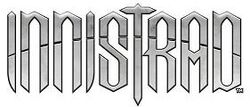Innistrad
- This page is about the expansion. For the plane, see Innistrad (plane). For other uses, see Innistrad (disambiguation).
| Innistrad | |||||
|---|---|---|---|---|---|
| Set Information | |||||
| Set symbol | |||||
| Symbol description | Two outward-facing, overlapping, stylized herons | ||||
| Design |
Mark Rosewater (lead), Richard Garfield, Jenna Helland, Graeme Hopkins, Tom LaPille | ||||
| Development |
Erik Lauer (lead), Mark Gottlieb, David Humpherys, Tom LaPille , Adam Lee, Kenneth Nagle | ||||
| Art direction | Jeremy Jarvis | ||||
| Release date | September 30, 2011 | ||||
| Plane | Innistrad | ||||
| Themes and mechanics | Double-faced cards, Curses, "Graveyard matters", "Human matters" | ||||
| Keywords/ability words | Flashback, Transform, Fight, Morbid | ||||
| Set size |
264 (15 basic lands, 107 commons, 67 uncommons, 59 rares, 16 mythic rares) | ||||
| Expansion code | ISD[1] | ||||
| Languages | English, Chinese (simplified & traditional), French, German, Italian, Japanese, Korean, Portuguese, Russian, Spanish | ||||
| Development codename | Shake | ||||
| Innistrad block | |||||
| |||||
| Magic: The Gathering Chronology | |||||
| |||||
| Scryfall Statistics | |||||
|
254 cards | |||||
Innistrad is the first set in the Innistrad block. It is the 56th Magic expansion and was released on September 30, 2011.
Set details
Innistrad is a top-down-designed Magic set,[2][3] meaning that it was designed and developed with flavor in mind first, "molding mechanics to fit the concept".[4] The expansion symbol of the set is a depiction of two outward-facing, overlapping, stylized herons.[5]
Innistrad has a gothic horror theme and makes use of horror tropes. It is the first set to thematically take place on the plane of Innistrad. The set features graveyard [6] and tribal mechanics, with the five main tribes each being split over an allied color pair.[7][8] Spirits primarily in white and blue, Zombies in blue and black, Vampires in black and red, Werewolves in red and green, and Humans primarily in green and white. In each of these pairs, the second color is considered the primary. There are also slight thematic differences between the tribes depending on the color, such as blue zombies being abominations of science in the vein of Frankenstein's Monster, while black Zombies are shambling corpses reanimated by magical spells.
Innistrad contains 264 cards (15 basic lands, 107 commons, 67 uncommons, 59 rares, 16 mythic rares), including randomly inserted premium versions of all cards in the set.[9] This is 15 more cards than any large expansion in recent history had. Innistrad also features several double-faced cards which have a card frame printed on each side; to handle these when playing without sleeves, three in every four booster packs include a checklist card instead of basic land. Due to basic lands becoming more rare, Innistrad only contains three basic land artworks rather than the usual four, further enlarging the number of functionally different cards.[10]
The double-faced cards were printed on a separate sheet from the other cards in the set, and every booster pack included a double-faced card. This means that boosters can have two rares and/or mythic rares without either being foil.[11]
Innistrad featured the last Magic Invitational card: Snapcaster Mage, created by Tiago Chan.[12]
Flavor and storyline
| “ | Horror Lurks Within | ” |
Innistrad is a plane of menace and dread where every creature hides a darker aspect. Here, hedonistic vampires stalk the shadows to quench their thirst, and the full moon can transform a simple villager into a savage werewolf.[13][14][15][16][17][18][19][20]
Magic Story
| Title | Author | Release Date | Setting (plane) | Featuring |
|---|---|---|---|---|
| The Cursed Blade | Ryan Miller | 2011-10-24 | Innistrad | Raben Amsel, Reika Eberhardt, Jofridus, Thatu Reiniger, Adila Rimheit, Holger Burk, Pitre, Lorelei Garensun, Jurgen Garensun, Gisa Cecani, Geralf Cecani, Elsi Rimheit, Albrecht, Mikaeus Cecani, Trinar, Reller, Detlef, Ekka, Joiva, Mahus, Amphe, Samson, Einrich, Wilhelm Brandt, Dartan, Jolen, Tobor, Lywer, Gregel, Lucilla, Dadine, H. Karlmahn, Iroe, Forlith, Hantsen, Whip, Adalee Burk, Jana Burk, Mikel Burk, Waechter, Gundie, Martyn, Leutster, Krig, Lipseg, Webbe, The Claw, Jorgin Rimheit, Cristemian, R. Meintor, Analise, Nordemann, Duerg, Frietz, Greftieg, Callan Ahnstat, Mauer |
Savor the Flavor
| Title | Author | Release Date | Setting (plane) | Featuring |
|---|---|---|---|---|
| Liliana's Mission | Doug Beyer | 2011-08-31 | Innistrad | Liliana, Kothophed, Garruk, Jace, Griselbrand |
| The Saint, the Geist, and the Angel | Doug Beyer | 2011-09-14 | Innistrad | Traft, Withengar |
| Deathtrap | Jenna Helland | 2011-10-26 | Innistrad | Nadia Bey, Master Bey, Kasten, Jorgson |
Marketing
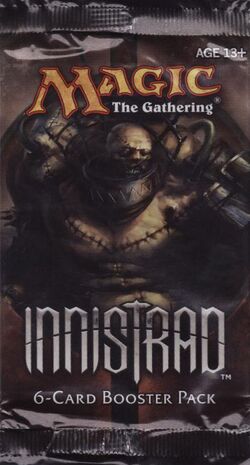
Innistrad was sold in 16-card boosters, 6-card boosters, five intro packs, two event decks and a fat pack.[21] The 16-card boosters featured artwork from Liliana of the Veil, Garruk Relentless, Terror of Kruin Pass, Olivia Voldaren and Bloodgift Demon.[22] The small booster featured artwork from Grimgrin, Corpse-Born.
Innistrad was introduced by way of an alternate reality game, in which bits of the story were leaked in the form of various letters, journal entries, and other in-world correspondences.[23][24] The prerelease of the set was September 24–25, 2011,[25] the launch party on September 30–October 3, 2011, the Magic Online release was October 17, 2011 and the Game Day was October 29–30, 2011. The prerelease promo was the double faced Mayor of Avabruck / Howlpack Alpha[26]; the launch party promo was Ludevic's Test Subject / Ludevic's Abomination[27]; and the Game Day promo was a full-art Diregraf Ghoul, with the top 8 receiving a full-art foil Elite Inquisitor.[28] The Buy-a-Box card was Devil's Play.[26]
Regular boosters of Innistrad come with a bonus sixteenth card that is either a checklist card, a creature token, or rules card with an advertisement on the reverse side.
Tokens
The Innistrad tokens in numerical order are:[29]
4/4 Angel with flying produced by Geist of Saint Traft
1/1 Spirit with flying produced by Doomed Traveler, Geist-Honored Monk, Mausoleum Guard, Midnight Haunting, and Moorland Haunt
2/2 Homunculus produced by Stitcher's Apprentice
5/5 Demon with flying produced by Skirsdag High Priest
2/2 Vampire with flying produced by Bloodline Keeper and Lord of Lineage, its back face
1/1 Wolf with deathtouch produced by Garruk, the Veil-Cursed
2/2 Zombie (3 different images) produced by Undead Alchemist, Army of the Damned, Endless Ranks of the Dead, Moan of the Unhallowed, and Cellar Door
*/* Ooze with "This creature's power and toughness are each equal to the number of slime counters on Gutter Grime." produced by Gutter Grime
1/2 Spider with reach produced by Spider Spawning
2/2 Wolf produced by Garruk Relentless, Kessig Cagebreakers, and Howlpack Alpha
Themes and mechanics
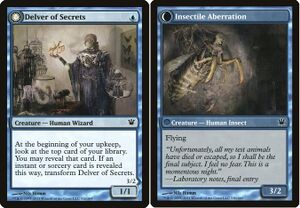
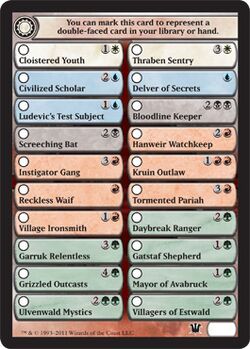
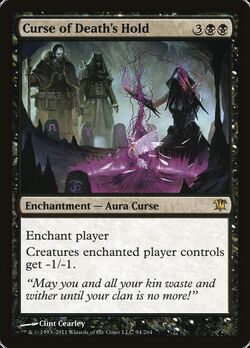
Innistrad is the first set to have cards with different card backs. These cards have two card faces, one on each side, and are used for the transformation mechanic, changing creatures into different creatures and back by turning the card over.[30][31] When playing with double-faced cards, players may use a checklist which has a regular card back and the player marks on the card which double-faced card the checklist card is supposed to represent. Whenever the card is in a public zone, the checklist card is replaced with the double-faced card. Playing with only the double-faced card is also allowed if the player is playing with opaque sleeves.[32]
The transformation mechanic simply consists of the word "transform" written on the card in a sentence, similar to sacrifice, counter, or flip. The mechanic also introduces new symbols representing a sun and a moon which appear to the left of a card name similar to the tombstone icon marking graveyard-based mechanics in Odyssey block. The symbols specifically indicate the creature before transformation (day) or after transformation (night). Transforming creatures always enter the battlefield as they are before transformation, and once transformed not all creatures can transform back. During transformations, Auras, Equipment, and counters stay on the creature.
Innistrad also introduces a new subtype for Enchantments named "Curse", which are simply Auras that enchant players and have a detrimental effect. The set is partially graveyard-based and features the return of flashback which originated in Odyssey and was reprinted during Time Spiral block. It also introduces the keyword action Fight, which represents the ability of Arena or Tahngarth, Talruum Hero. Two creatures that fight deal damage equal to their power to each other. Innistrad also features the new ability word Morbid in which creatures get benefits if another creature died the turn they entered the battlefield.[33][34]
The set makes use of tribal mechanics, with Vampires, Zombies, Werewolves, Spirits, and Humans giving bonuses to each other and having abilities that work against other tribes. A small theme of using +1/+1 counters is also used in the set, particularly with Vampires growing stronger by dealing damage. References to the number 13 are sprinkled throughout Innistrad cards. Another minor theme in Innistrad is the Equipment used by humans to fight the monsters.
Liliana Vess returned as a new card named Liliana of the Veil. Garruk Wildspeaker also returned on a new card, named Garruk Relentless. Garruk Relentless is a double-faced card and the first Planeswalker card with five loyalty abilities. It is also the first Planeswalker card with a continuous triggered ability and the first green-black Planeswalker.[35]
Creature types
No novel creature types were introduced in this expansion.
Cycles
Innistrad has five cycles:
| Cycle name | |||||
|---|---|---|---|---|---|
| Rare flashback cards | Divine Reckoning | Cackling Counterpart | Sever the Bloodline | Devil's Play | Creeping Renaissance |
| Each of these rare spells has a more expensive flashback cost. | |||||
| Allied flashback cards | Feeling of Dread | Forbidden Alchemy | Bump in the Night | Ancient Grudge | Travel Preparations |
| Each of these common spells has a flashback cost involving the next color on the color wheel. | |||||
| Enemy flashback cards | Rally the Peasants | Memory's Journey | Unburial Rites | Desperate Ravings | Spider Spawning |
| Each of these uncommon spells has a flashback cost involving the enemy color two slots earlier on the color wheel. | |||||
| Cycle name | |||||
| Allied utility lands | Moorland Haunt | Nephalia Drownyard | Stensia Bloodhall | Kessig Wolf Run | Gavony Township |
| A cycle of rare lands that tap for one colorless mana, or require an activation involving both colors of an allied pair to have an effect.[36] | |||||
| Cycle name | |||||
| Enemy color check lands | Isolated Chapel | Sulfur Falls | Woodland Cemetery | Clifftop Retreat | Hinterland Harbor |
| Lands that can produce either color of an Enemy-colored pair and come into play tapped unless the player controls a land with a basic land type of either color. This cycle completes a ten-card cycle with the allied-colored checklands first introduced in Magic 2010 and reprinted multiple times in subsequent Core Sets.[37] | |||||
Vertical cycles
Innistrad has two vertical cycles:
| Cycle name | ||||
|---|---|---|---|---|
| Stitcher Skaabs | Stitched Drake Makeshift Mauler |
Skaab Goliath | Skaab Ruinator | |
| Blue undercosted creatures that require creature cards to be exiled from the graveyard to be cast. Armored Skaab bears a similar name and is also a blue zombie, but does not share the same effect. | ||||
| Bloodsuckers | Bloodcrazed Neonate | Rakish Heir | Falkenrath Marauders Stromkirk Noble | |
| Red Vampires become more powerful when they deal damage to an opponent. Curse of Stalked Prey and Stromkirk Patrol also have similar abilities. | ||||
Mega cycle
Reprinted cards
- Ancient Grudge, first printed in Time Spiral
- Blazing Torch, first printed as an uncommon in Zendikar, now a common
- Curiosity, first printed in Exodus, last seen in Eighth Edition
- Dissipate, first printed in Mirage
- Ghost Quarter, first printed in Dissension
- Mulch, first printed in Stronghold
- Naturalize, first printed in Onslaught, last seen in Magic 2012
- Shimmering Grotto, first printed in Lorwyn
- Think Twice, first printed in Time Spiral
Functional reprints
- Moon Heron, functional reprint of Snapping Drake (Portal) and Talas Air Ship (Portal Second Age), save for creature type
- Riot Devils, functional reprint of Minotaur Warrior (Portal), save for creature type
- Rotting Fensnake, functional reprint of Dross Crocodile (Fifth Dawn) and Skeletal Crocodile (Portal), save for creature type
- Thraben Purebloods, functional reprint of Siege Mastodon (Magic 2010), save for creature type
- Traveler's Amulet, functional reprint of Wanderer's Twig (Lorwyn)
- Voiceless Spirit, functional reprint of Pegasus Charger (Urza's Saga), save for creature type
Colorshifted
- Purify the Grave, white colorshifted version of Coffin Purge (Odyssey)
- Stony Silence, white colorshifted version of Null Rod (Weatherlight)
Card comparisons
Notable cards
- See also: Innistrad/Trivia
- The checkland cycle (such as Sulfur Falls) continued from Magic 2010 would go on to substantial usage for mana fixing in Standard, although they have mostly been surpassed in Modern and Pioneer by stronger lands.
- Blasphemous Act was one of the best board sweepers in its period of Standard legality, where it often cost very little mana to clear the entire board. It remains one of the best sweepers in multiplayer formats like Commander where each player contributes to its cost reduction.
- Delver of Secrets (along with its back face, Insectile Aberration), sometimes called a "blue Nacatl" after Wild Nacatl, is arguably the most effective cheap threat in its color (although it was not seen that way either in design or upon its release), widely played in aggro-control tempo decks across all constructed formats.
- Snapcaster Mage is the Magic Invitational prize card Tiago Chan made and finally collected after four years of development. It would be the last Invitational card released. Snapcaster Mage was a defining card in Standard and has had a significant impact in Modern and Legacy as well.
- Geist of Saint Traft is a powerful early-game rush card, given that it has hexproof and attacks for 6 damage on turn 4. Its weakness to blockers was often overcome with bounce or equipment.
- Olivia Voldaren is very reminiscent of Memnarch, being able to turn enemy creatures into vampires and then gaining control of them, making her a long-game haymaker that dominated other creature decks.
- Liliana of the Veil became one of the most powerful planeswalkers ever printed until the FIRE era of 2019, second only to the infamous Jace, the Mind Sculptor. It was a Modern staple for many years, especially in Jund and Grixis, and in BUG decks in Legacy.
- Diregraf Ghoul follows a long tradition of 2/2 Zombies for
which includes Sarcomancy, Carnophage and Accursed Centaur. The first two cards saw widespread tournament play in Suicide Black decks.
- Laboratory Maniac is an alternate-win card. It inspired various other empty-library win conditions.
- Avacyn's Pilgrim is a new one-mana mana dork that adds off-color mana, similar to Elves of Deep Shadow. Like most one-mana dorks, it saw substantial use in Standard.
- Invisible Stalker is the epitome of an un-interactable creature that had been used in Modern for years in decks that can increase its power such as Hammer Time and Infect. Its combo with Butcher's Cleaver in Limited was one of its few failings.
- Kessig Wolf Run helped red-green aggro decks dominate in Standard and was used in certain Ponza and Amulet Titan decks in Modern.
- Past in Flames is a powerful spell enabler that has been used by Modern and Legacy storm decks to recast all of the ritual and card draw spells in their graveyard.
- Unburial Rites is one of the strongest reanimator spells in Modern, with a convenient graveyard mode that works particularly well in decks that plan to mill themselves.
- Fiend Hunter is one of the first creatures to be given an effect similar to Oblivion Ring, similar to the much older Faceless Butcher, and it proved powerful enough to see heavy play in Standard and have success in the early days of Modern.
- Champion of the Parish proved to be a powerful payoff for human decks that were initially created in Standard and had longevity in the Modern format.
- Stony Silence is a simple but impactful sideboard card for multiple formats from Modern to Legacy to Vintage, where it can slow down artifact-centric decks.
- Prey Upon is the first green spell to use the new fight keyword action and has since seen reprints in half a dozen Standard sets as a simple but effective removal spell.
- Spider Spawning was part of an infamously strong strategy in Limited formats that took advantage of self-milling to create an incredible number of Spider tokens. It was often joked that Innistrad flashback draft pods would half be made up of Spawning drafters, all of whom had bad decks.
- Tree of Redemption is the first card to involve exchanging a player's life total with something other than another player's life total and remains one of the only to do so in addition to its successor Tree of Perdition and Evra, Halcyon Witness.
- The flavor text of Ancient Grudge's reprint received significant criticism for its belabored clarification and length.
- Moonmist stands out as the only way to forcibly transform DFCs that are not intended to transform back. As DFC designs and transform triggers evolved, it exposes the reasons why some DFCs transform the way they do.
Banned and restricted cards
- Intangible Virtue became part of a very powerful Tokens deck in Standard when combined with Lingering Souls from Dark Ascension. Both cards were later banned in Innistrad block constructed, and were part of the Modern BW Tokens deck, along with Morningtide's Bitterblossom.
Reception
In general, Innistrad is often considered one of the best sets in Magic history. The combination of a perfect limited experience, extremely powerful and varied cards for standard in all rarities, and the large number of cards used for eternal formats has received universal acclaim from magic players. The only sets that come close to the popularity of this set are Ravnica: City of Guilds and Zendikar.
Over time, Innistrad has cemented its legacy as one of the best sets ever. In 2019, Mark Rosewater ranked Innistrad first out of 28 sets that he led/co-led design on, saying that he considered it to be his "tightest" design [38]. Also in 2019, Luis Scott Vargas and Marshall Sutcliffe both ranked 3x Innistrad as the best Draft format ever in a Limited Resources podcast [39].
Preconstructed decks
Intro decks
Innistrad has five bicolored theme decks.[40]
| Intro pack name | Colors Included | Foil rare | ||||
|---|---|---|---|---|---|---|
| Spectral Legions | W | U | – | – | – | Angel of Flight Alabaster |
| Carnival of Blood | – | – | B | R | – | Falkenrath Marauders |
| Repel the Dark | W | – | – | – | G | Elder of Laurels |
| Eldritch Onslaught | – | U | – | R | – | Sturmgeist |
| Deathly Dominion | – | – | B | – | G | Skirsdag High Priest |
Event decks
Innistrad has two Event decks.[41]
| Event deck name |
Colors Included | ||||
|---|---|---|---|---|---|
| Deathfed | – | U | B | – | G |
| Hold the Line | W | – | – | – | – |
References
- ↑ Product info
- ↑ Mark Rosewater (September 05, 2011). "C'mon Innistrad, Part 1". magicthegathering.com. Wizards of the Coast. Archived from the original on 2018-03-11.
- ↑ Mark Rosewater (August 27, 2012). "State of Design 2012". magicthegathering.com. Wizards of the Coast.
- ↑ Mark Rosewater (June 9, 2003). "Top Down and Goal". magicthegathering.com. Wizards of the Coast.
- ↑ Matt Cavotta (December 12, 2011). "Before, During, and After". magicthegathering.com. Wizards of the Coast. Archived from the original on 2020-08-05.
- ↑ Mark Rosewater (September 12, 2011). "C'mon Innistrad, Part 2". magicthegathering.com. Wizards of the Coast. Archived from the original on 2020-09-29.
- ↑ Jenna Helland (December 26, 2011). "Innistrad from the Top". magicthegathering.com. Wizards of the Coast. Archived from the original on 2021-04-29.
- ↑ Tom LaPille (September 23, 2011). "The Colors of your Nightmares". magicthegathering.com. Wizards of the Coast. Archived from the original on 2021-04-29.
- ↑ Monty Ashley (March 14, 2011). "Announcing Innistrad". magicthegathering.com. Wizards of the Coast. Archived from the original on 2018-10-24.
- ↑ Mark Rosewater (August 29, 2011). "Every Two Sides Has a Story". magicthegathering.com. Wizards of the Coast. Archived from the original on 2017-11-23.
- ↑ Mark Rosewater (October 10, 2011). "Unanswered Questions: Innistrad". magicthegathering.com. Wizards of the Coast. Archived from the original on 2018-01-26.
- ↑ Monty Ashley (October 24, 2011). "The Saga of Snapcaster Mage". magicthegathering.com. Wizards of the Coast. Archived from the original on 2020-09-22.
- ↑ Wizards of the Coast (September, 2011). "The World of Innistrad". magicthegathering.com. Wizards of the Coast. Archived from the original on 2021-04-29.
- ↑ Monty Ashley (August 31, 2011). "Innistrad Art Gallery". magicthegathering.com. Wizards of the Coast. Archived from the original on 2021-04-29.
- ↑ Magic Creative Team (August 24, 2011). "A Planeswalker's Guide to Innistrad: Introduction". magicthegathering.com. Wizards of the Coast. Archived from the original on 2020-08-12.
- ↑ Doug Beyer (August 31, 2011). "Liliana's Mission". magicthegathering.com. Wizards of the Coast. Archived from the original on 2021-04-29.
- ↑ Doug Beyer (September 7, 2011). "Champion of the Parish". magicthegathering.com. Wizards of the Coast. Archived from the original on 2021-04-29.
- ↑ Doug Beyer (September 13, 2011). "The Saint, the Geist, and the Angel". magicthegathering.com. Wizards of the Coast. Archived from the original on 2017-10-17.
- ↑ Doug Beyer (September 20, 2011). "Postcards from Innistrad: The Nonbasics". magicthegathering.com. Wizards of the Coast. Archived from the original on 2020-09-23.
- ↑ Jeremy Jarvis (September 05, 2011). "Creating the Art of Innistrad". magicthegathering.com. Wizards of the Coast.
- ↑ Monty Ashley (September 12, 2011). "Innistrad Fat Pack". magicthegathering.com. Wizards of the Coast. Archived from the original on 2021-04-19.
- ↑ Monty Ashley (August 30, 2011). "Innistrad Boosters". magicthegathering.com. Wizards of the Coast. Archived from the original on 2021-04-29.
- ↑ Ryan Miller (October 24, 2011). "Re: Josh Brauer". magicthegathering.com. Wizards of the Coast. Archived from the original on 2021-04-29.
- ↑ Ryan Miller and Team (October 24, 2011). "The Cursed Blade". magicthegathering.com. Wizards of the Coast. Archived from the original on 2020-08-13.
- ↑ Tim Willoughby (September 12, 2011). "Innistrad Prerelease Primer". magicthegathering.com. Wizards of the Coast. Archived from the original on 2020-11-12.
- ↑ a b Monty Ashley (August 29, 2011). "Innistrad Promo Cards". magicthegathering.com. Wizards of the Coast. Archived from the original on 2020-08-13.
- ↑ Monty Ashley (November 16, 2011). "Alternate Abominations". magicthegathering.com. Wizards of the Coast. Archived from the original on 2020-11-12.
- ↑ Monty Ashley (October 12, 2011). "Innistrad Game Day". magicthegathering.com. Wizards of the Coast. Archived from the original on 2020-08-09.
- ↑ Monty Ashley (September 19, 2011). "Innistrad Tokens". magicthegathering.com. Wizards of the Coast. Archived from the original on 2018-03-20.
- ↑ Monty Ashley (September 21, 2011). "The Two Sides". magicthegathering.com. Wizards of the Coast. Archived from the original on 2019-08-11.
- ↑ Tom LaPille (September 16, 2011). "Werewolves Gone Wild". magicthegathering.com. Wizards of the Coast. Archived from the original on 2021-04-29.
- ↑ Wizards of the Coast (August 28, 2011). "Double-Faced Card Rules". magicthegathering.com. Wizards of the Coast. Archived from the original on 2018-05-27.
- ↑ Wizards of the Coast (August 28, 2011). "Innistrad Mechanics". magicthegathering.com. Wizards of the Coast. Archived from the original on 2021-02-25.
- ↑ Zac Hill (November 11, 2011). "Morbid Thoughts". magicthegathering.com. Wizards of the Coast. Archived from the original on 2021-01-22.
- ↑ Tom LaPille (September 02, 2011). "Garruk Flips Out". magicthegathering.com. Wizards of the Coast. Archived from the original on 2020-11-11.
- ↑ Monty Ashley (November 02, 2011). "A Bit of Atmosphere". magicthegathering.com. Wizards of the Coast. Archived from the original on 2020-10-20.
- ↑ Tom LaPille (September 9, 2011). "Out on the Township". magicthegathering.com. Wizards of the Coast. Archived from the original on 2021-04-29.
- ↑ Mark Rosewater (December 9, 2019). "Even More Maro on Maro". magicthegathering.com. Wizards of the Coast.
- ↑ Marshall Sutcliffe, Luis Scott Vargas (August 1, 2019). "Limited Resources 503 – Top 5 Best Draft Formats Ever (And Why They Are Great)". Limited Resources.
- ↑ Monty Ashley (September 22, 2011). "Innistrad Intro Pack Decklists". magicthegathering.com. Wizards of the Coast. Archived from the original on 2020-11-12.
- ↑ Wizards of the Coast (October 11, 2011). "Innistrad Event Deck Decklists". magicthegathering.com. Wizards of the Coast. Archived from the original on 2020-05-31.
External links
- Innistrad product information page — Wizards of the Coast
- Planes of Existence: Innistrad
- Mark Rosewater (August 23, 2021). "Innistrad Design Handoff Document". magicthegathering.com. Wizards of the Coast.
- Mark Rosewater (May 22, 2023). "Lessons Learned, Part 3". magicthegathering.com. Wizards of the Coast.
